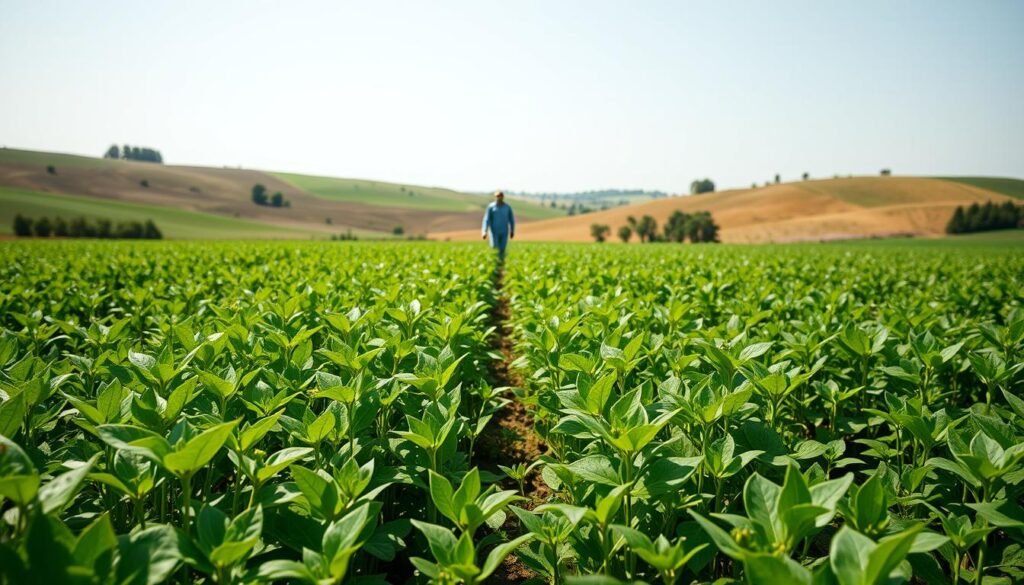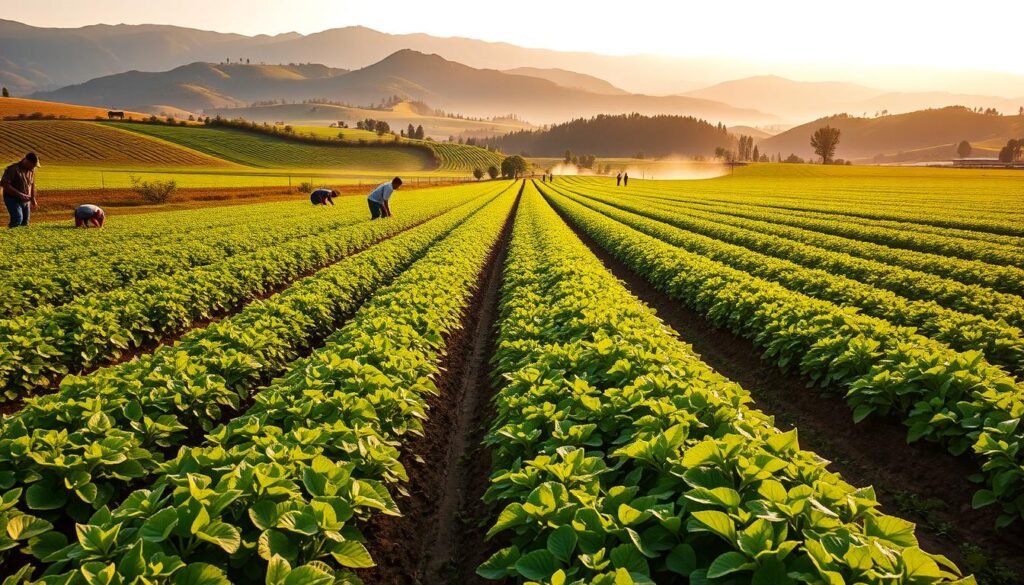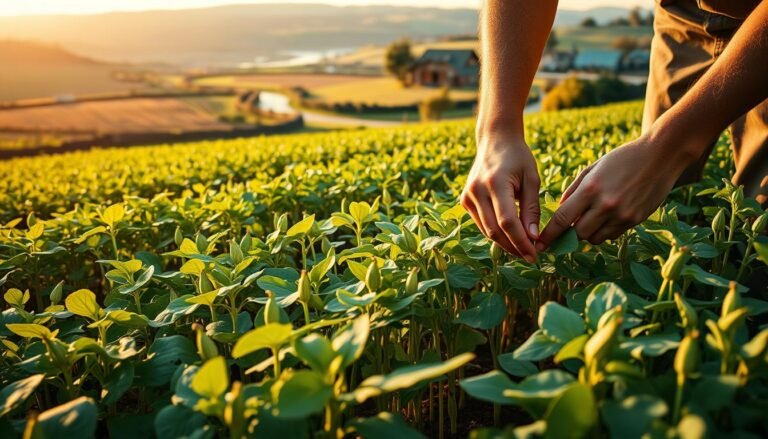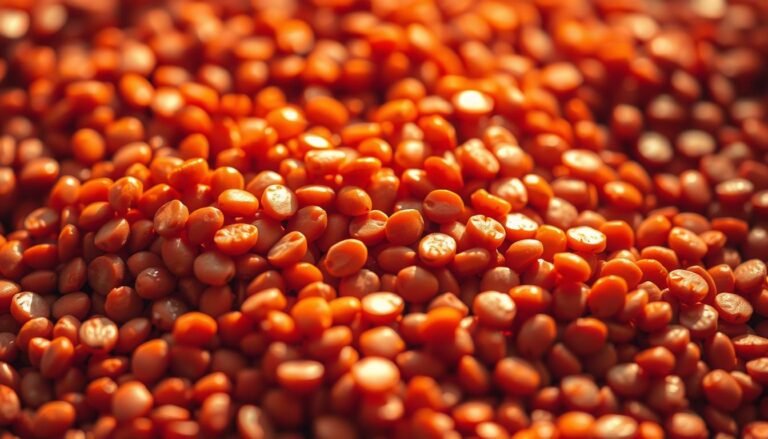Lentil cultivation is a valuable practice for sustainable agriculture, providing a rich source of protein and enriching soil health. Lentils are a nutritious crop that has been a staple in many cuisines around the world.
The process of lentil growing involves careful planning and attention to the ideal climate for lentils. In this article, we will explore the key facts about lentil cultivation, the climate required for optimal growth, and the harvesting process.
Key Takeaways
- Lentil cultivation is beneficial for sustainable agriculture.
- The ideal climate for lentils is crucial for optimal growth.
- Lentil growing requires careful planning and attention.
- Lentils are a rich source of protein and enrich soil health.
- The harvesting process is an essential part of lentil cultivation.
Understanding Lentils: An Overview
Lentils are a fundamental ingredient in many cuisines around the world, offering a rich source of protein and fiber. They are a cool-season crop, thriving in temperate climates. Understanding the basics of lentils is crucial for appreciating their cultivation process.
What Are Lentils?
Lentils are a type of legume, characterized by their lens-shaped seeds. They come in various colors, including red, green, and brown, each with slightly different cooking times and textures. Lentils are known for their high nutritional value, being rich in protein, fiber, and essential minerals.
Types of Lentils Suitable for Growing
There are several types of lentils suitable for cultivation, including red, green, and brown lentils. The choice of type often depends on the local climate and market demand.
| Type of Lentil | Cooking Time | Texture |
|---|---|---|
| Red Lentils | 20-25 minutes | Soft |
| Green Lentils | 30-40 minutes | Firm |
| Brown Lentils | 40-45 minutes | Chewy |
Nutritional Value and Uses
Lentils are not only a versatile ingredient but also packed with nutrients. They are an excellent source of plant-based protein and dietary fiber, making them a healthy addition to various meals. Lentils are used in soups, stews, salads, and as a meat substitute in many recipes.
The History and Importance of Lentil Growing
Lentil growing has a rich history that spans thousands of years, with its significance extending beyond mere culinary use. This ancient crop has been a cornerstone of nutrition and sustainability in many cultures.
Historical Significance of Lentils
Lentils have been cultivated for millennia, with evidence of their consumption dating back to ancient civilizations in the Middle East, North Africa, and South Asia. They were valued not only as a food source but also for their ability to thrive in challenging environmental conditions.
“Lentils are one of the earliest crops domesticated by humans, highlighting their importance in the development of agriculture.”
Economic Importance in Australian Agriculture
In Australia, lentil growing has become an important agricultural activity, contributing significantly to the economy. The country’s favorable climate and advanced farming techniques have made it an ideal place for lentil cultivation.
- Lentil crops provide a valuable source of income for farmers.
- They contribute to the agricultural GDP, enhancing the overall economic performance of the sector.
Sustainability Benefits of Lentil Crops
Lentils are renowned for their sustainability benefits, including nitrogen fixation, which improves soil health, and drought tolerance, making them ideal for water-scarce regions.
The cultivation of lentils supports sustainable agriculture practices by reducing the need for synthetic fertilizers and conserving water resources. This makes lentil growing an attractive option for farmers looking to adopt more environmentally friendly farming methods.
Ideal Climate Conditions for Lentil Growing
Understanding the ideal climate for lentil growing is essential for maximizing crop yield in Australia. Lentils are cool-season crops that thrive in temperate climates with moderate rainfall.
Temperature Requirements
Lentils have specific temperature requirements for optimal growth. They prefer daytime temperatures between 15°C and 25°C and nighttime temperatures around 10°C to 15°C. Temperatures outside this range can lead to reduced yields or crop failure.
Rainfall and Moisture Needs
Adequate rainfall is crucial for lentil crops, especially during the germination and pod-filling stages. Lentils generally require about 250-300 mm of rainfall during the growing season. However, excessive moisture can lead to waterlogging, which is detrimental to the crop.
Australian Climate Zones Suitable for Lentils
Australia’s temperate regions are well-suited for lentil cultivation. The southern parts of Western Australia, South Australia, Victoria, and New South Wales have climate conditions that are particularly favorable. These regions offer the cool winters and moderate summers that lentils prefer.
Key factors to consider for lentil growing in Australia include:
- Cool-season crop characteristics
- Moderate rainfall during the growing season
- Temperate climate zones

Soil Requirements for Successful Lentil Cultivation
The right soil conditions are essential for a bountiful lentil harvest. Lentil cultivation requires careful consideration of soil type, pH levels, and nutrient availability to ensure optimal growth.
Optimal Soil Types
Lentils thrive in well-drained loamy soils. These soils provide the right balance of water retention and aeration, promoting healthy root development. Well-drained loamy soils are particularly beneficial as they reduce the risk of waterlogging, which can be detrimental to lentil crops.
pH Levels and Nutrient Requirements
The ideal pH range for lentil cultivation is between 6.0 and 7.5. Soil pH outside this range can lead to nutrient deficiencies and reduced yields. Lentils also require adequate nutrients, including phosphorus, potassium, and sulfur. Ensuring the right pH and nutrient levels is crucial for optimal lentil growth.
- Phosphorus promotes root development and flower formation.
- Potassium helps in overall plant health and resistance to disease.
- Sulfur is essential for protein synthesis and plant vigor.
Soil Preparation Techniques
Effective soil preparation is key to successful lentil cultivation. Techniques include:
- Tillage to loosen the soil and improve aeration.
- Incorporating organic matter to enhance soil structure and fertility.
- Using conservation tillage to reduce soil erosion and preserve moisture.
By focusing on these soil preparation techniques and ensuring optimal soil conditions, lentil farmers can significantly improve their crop yields and contribute to sustainable agricultural practices.
Selecting the Right Lentil Varieties for Australian Conditions
With various lentil varieties available, Australian farmers must choose those that offer the best disease resistance and yield potential. The right variety can significantly impact the success of lentil cultivation.
Popular Lentil Varieties in Australia
Some of the most commonly grown lentil varieties in Australia include the Northfield and PBA Herald XT. These varieties have been bred for their adaptability to Australian conditions and have shown promising results in terms of yield and disease resistance.
Disease-Resistant Varieties
Disease resistance is a critical factor in lentil cultivation. Varieties like PBA Herald XT have been developed with resistance to specific diseases, reducing the need for fungicides and minimizing crop loss.
Yield Potential Considerations
When selecting a lentil variety, farmers should also consider the yield potential. Factors such as soil type, climate, and farming practices can influence yield. Varieties with high yield potential, such as Northfield, can provide better returns on investment.
By carefully evaluating these factors and choosing the right lentil variety, Australian farmers can optimize their crop production and achieve a successful harvest.
Lentil Growing Season and Timing in Australia
To maximize lentil production, farmers must align their planting schedule with the optimal growing season. In Australia, the lentil growing season is influenced by regional climate conditions.
Optimal Planting Times by Region
Lentils are typically planted in late winter or early spring in Australia. In the southern regions, such as South Australia and Victoria, the ideal planting time is usually around August or September. For northern regions like New South Wales and Queensland, planting often occurs in May or June.
Growth Cycle Duration
The growth cycle of lentils generally lasts between 100 to 150 days, depending on the variety and environmental conditions. Early maturing varieties can be ready for harvest in as little as 90 days, while late-maturing types may take longer.
Seasonal Considerations
Farmers must consider seasonal factors such as rainfall, temperature, and potential frost when planning their lentil crop. Adequate moisture during the growing season is crucial, while excessive rain can lead to disease issues.
By understanding these factors, Australian farmers can optimize their lentil yields and contribute to a successful harvest.
Essential Lentil Growing Techniques for Success
Successful lentil cultivation begins with mastering essential growing techniques that optimize crop yield and quality. Lentil growing is a nuanced process that requires careful attention to detail, from seed preparation to harvesting. By employing the right techniques, farmers can significantly improve their lentil crop’s resilience and productivity.
Seed Preparation and Inoculation
Proper seed preparation is crucial for healthy lentil crops. This includes inoculating the seeds with the appropriate Rhizobium strain, which enhances nitrogen fixation and promotes robust plant growth. Farmers should use high-quality seeds and follow recommended inoculation procedures to ensure optimal results.
- Use certified disease-free seeds to minimize the risk of crop failure.
- Apply the correct Rhizobium inoculant according to the manufacturer’s instructions.
- Store inoculated seeds in a cool, dry place until planting.
Planting Depth and Spacing
The depth and spacing of lentil seeds are critical factors that influence crop establishment and yield. Planting at the correct depth ensures good soil-seed contact and adequate moisture uptake.
Key considerations include:
- Planting seeds at a depth of 3-5 cm to ensure good soil contact.
- Maintaining row spacings of 25-30 cm to facilitate air circulation and reduce disease risk.
- Aiming for a plant density that optimizes resource use and minimizes competition.
Equipment and Methods for Different Scales
The scale of lentil farming operations can vary significantly, from small plots to large commercial farms. The choice of equipment and planting methods should be tailored to the specific scale and conditions of the farm.
For small-scale farming, simple tools and manual planting methods may suffice, while larger operations may benefit from mechanized planting equipment that can efficiently cover more ground.
Water Management in Lentil Cultivation
Water management plays a vital role in lentil agriculture, impacting crop yield and quality. Lentils are relatively drought-tolerant but may require irrigation during dry spells to ensure optimal growth.
Irrigation Requirements and Systems
Lentil crops need adequate moisture, especially during flowering and pod formation. Efficient irrigation systems can help maintain the right balance of water. In Australia, farmers often use drip irrigation to minimize water loss and reduce the risk of waterlogging.
Drought Tolerance Strategies
To enhance drought tolerance, farmers can adopt several strategies. These include using drought-resistant lentil varieties and implementing conservation tillage to improve soil moisture retention. Additionally, careful planning of planting times can help lentil crops make the most of available rainfall.
Waterlogging Prevention in Australian Soils
Waterlogging can be detrimental to lentil crops, leading to root rot and reduced yields. To prevent waterlogging, farmers should ensure good drainage in their fields. This can be achieved by creating raised beds and using laser leveling to improve soil surface evenness.
By implementing these water management strategies, lentil farmers in Australia can improve crop resilience and productivity.
Fertilization and Nutrient Management for Lentils
Nutrient management plays a vital role in the successful cultivation of lentils. Lentils require a balanced diet of nutrients to grow healthily and produce high yields.
Essential Nutrients for Healthy Lentil Plants
Lentils need adequate nutrients, including phosphorus and potassium, for optimal growth. Phosphorus is crucial for root development and flower formation, while potassium helps in overall plant health and resistance to disease.

Organic vs. Synthetic Fertilizers
Farmers can choose between organic and synthetic fertilizers. Organic fertilizers, such as compost or manure, release nutrients slowly and improve soil structure. Synthetic fertilizers provide quick nutrient availability but may harm soil health if overused.
Application Timing and Methods
The timing and method of fertilizer application are critical. Fertilizers should be applied at the right growth stage, typically at planting or during early growth. The table below summarizes the application timing and methods for lentil crops.
| Nutrient | Application Timing | Method |
|---|---|---|
| Phosphorus | At planting | Band placement |
| Potassium | At planting or early growth | Broadcast or band placement |
By understanding and implementing effective fertilization and nutrient management strategies, lentil farmers can enhance crop health and productivity.
Weed Management Strategies for Lentil Crops
Effective weed management is crucial for successful lentil cultivation in Australia. Weeds compete with lentil crops for water, nutrients, and light, potentially reducing yields and affecting crop quality. Implementing a comprehensive weed management strategy is essential to mitigate these impacts.
Common Weeds in Australian Lentil Fields
Australian lentil fields are often plagued by various weed species. Common weeds include Brassica spp. (wild turnip), Lolium spp. (ryegrass), and Avena spp. (wild oats). These weeds not only compete with lentils for resources but can also complicate harvesting processes.
Pre-Emergent Weed Control
Pre-emergent herbicides are a critical tool in managing weeds before they emerge. Applying these herbicides before or at the time of sowing can significantly reduce weed pressure. Products containing active ingredients such as trifluralin are commonly used for pre-emergent control in lentil crops. For more detailed information on lentil weed control, visit Alberta Pulse’s resource.
Post-Emergent Weed Management
Despite pre-emergent controls, weeds may still emerge. Post-emergent herbicides offer a solution to control weeds that have germinated. Selective herbicides can target specific weed species without damaging the lentil crop. It’s crucial to identify the weed species and choose an appropriate herbicide to ensure effective control while minimizing crop damage.
By integrating pre-emergent and post-emergent weed management strategies, lentil growers in Australia can effectively reduce weed competition, enhance crop yields, and improve overall farm productivity.
Pest and Disease Management in Lentil Growing
Managing pests and diseases is a critical aspect of lentil cultivation in Australian agriculture. Effective management strategies are essential to protect lentil crops from damage and ensure a successful harvest.
Common Pests Affecting Australian Lentils
Lentil crops in Australia are susceptible to various pests, including pod borers and aphids. These pests can cause significant damage to the crop, reducing yields and affecting quality. Monitoring fields regularly is crucial to detect pest infestations early.
Disease Identification and Prevention
Diseases such as ascochyta blight and botrytis grey mould can severely impact lentil crops. Disease prevention involves using resistant varieties, practicing good crop rotation, and applying fungicides when necessary. Understanding the disease cycle and being able to identify symptoms early are key to effective disease management.
Integrated Pest Management Approaches
Integrated Pest Management (IPM) involves combining different control methods to manage pests and diseases effectively. This approach helps minimize the risk of developing pesticide-resistant pest populations and reduces environmental impact.
Biological Controls
Biological controls, such as using natural predators or parasites of pests, offer an environmentally friendly option for managing lentil pests. Encouraging beneficial insects in and around lentil fields can help control pest populations naturally.
Chemical Controls and Australian Regulations
Chemical controls, including insecticides and fungicides, are also used in lentil pest and disease management. It’s essential to follow Australian regulations regarding the use of these chemicals, including adhering to label instructions and withholding periods to ensure crop safety and minimize environmental impact.
By adopting a comprehensive IPM strategy that includes both biological and chemical controls, lentil growers in Australia can effectively manage pests and diseases, ensuring a healthy and productive crop.
Crop Rotation and Companion Planting with Lentils
Crop rotation and companion planting play a vital role in improving lentil yields and soil health. By adopting these practices, farmers can create a more sustainable and resilient agricultural system.
Benefits of Crop Rotation
Crop rotation offers numerous benefits for lentil cultivation, including improved soil health, reduced pest and disease pressures, and increased biodiversity. Rotating lentils with cereals and oilseeds can enhance soil structure and fertility, leading to better overall crop performance. For more information on lentil growing, you can visit this guide.
Suitable Rotation Crops for Australian Farms
In Australia, lentils can be rotated with various crops to achieve optimal benefits. Some suitable rotation crops include wheat, barley, canola, and chickpeas. The choice of rotation crop depends on factors like climate, soil type, and market demand.
| Rotation Crop | Benefits |
|---|---|
| Wheat | Improves soil structure, reduces disease pressure |
| Canola | Breaks disease cycles, enhances soil fertility |
| Chickpeas | Fixes nitrogen, improves soil health |
Companion Plants for Enhancing Lentil Growth
Companion planting can also enhance lentil growth by providing support, shading, or pest control. Some beneficial companion plants for lentils include oats, flax, and marigold. These plants can help create a more favorable growing environment for lentils.
Harvesting Lentils: Timing and Techniques
Lentil harvesting is a nuanced process that demands attention to detail and an understanding of the crop’s maturity signs. The success of this process is crucial for maximizing yields and maintaining the quality of the lentils.
Signs of Harvest Readiness
Lentils are ready to harvest when the pods turn yellow and dry. This change in color and moisture content indicates that the lentils have reached maturity. Monitoring the crop regularly during the latter stages of growth is essential to catch the optimal harvest time.
Harvesting Methods and Equipment
Mechanical harvesters are commonly used for lentil harvesting in Australia. These machines are designed to efficiently cut the lentil plants, gather them into windrows, and thresh the lentils from the pods. Choosing the right equipment based on the scale of the operation and the specific conditions of the field is vital.
Minimizing Harvest Losses
To minimize losses during harvesting, it’s crucial to adjust the harvesting equipment properly and operate it at the optimal speed. Pre-harvest preparation, such as controlling weeds and ensuring the field is relatively flat, can also significantly reduce losses.
Timing Considerations for Australian Weather Patterns
Australia’s variable climate means that the timing of lentil harvesting can vary significantly from year to year and region to region. Understanding local weather patterns and being prepared to harvest when the crop is ready is key to successful lentil production.
By paying close attention to the signs of harvest readiness, using appropriate harvesting techniques, and considering the local weather patterns, lentil growers in Australia can optimize their harvests.
Post-Harvest Handling and Storage
Effective post-harvest handling and storage practices are vital for preserving the quality and nutritional value of lentil crops. Proper handling ensures that the lentils remain in good condition from the farm to the consumer.
Cleaning and Processing
After harvesting, lentils need to be cleaned to remove any debris, stones, or broken lentils. This process not only improves the quality of the lentils but also enhances their marketability. Advanced cleaning machinery can significantly reduce labor costs and improve efficiency.
Key steps in the cleaning process include:
- Removing impurities and foreign materials
- Sorting lentils by size and quality
- Using air classification or optical sorters for precision
Drying Techniques
Drying lentils to the appropriate moisture level is critical for safe storage. The ideal moisture content for stored lentils is around 12%. Various drying techniques can be employed, including sun drying and mechanical drying.
Effective drying methods include:
- Sun drying on concrete or asphalt surfaces
- Mechanical drying using dryers with controlled temperature and airflow
Storage Conditions and Duration
Proper storage conditions are essential for maintaining the quality of dried lentils. Storage facilities should be clean, dry, and pest-free. Lentils should be stored in airtight containers or silos to protect them from moisture and pests.
Australian Storage Standards and Best Practices
In Australia, lentil storage facilities must adhere to strict guidelines to ensure the quality and safety of the stored lentils. This includes regular inspections for pests and moisture, as well as maintaining a cool, dry environment.
Best practices for lentil storage in Australia involve:
- Using silos or bins that are designed for grain storage
- Implementing a robust aeration system to maintain a consistent temperature
- Monitoring for pests and diseases regularly
Conclusion: Successful Lentil Growing in Australia
Lentil growing is a valuable component of Australian agriculture, offering numerous benefits for farmers and the environment. By understanding the ideal climate conditions, soil requirements, and essential growing techniques, Australian farmers can achieve successful lentil cultivation.
The practices outlined in this article provide a comprehensive guide for lentil growing in Australia. From selecting the right lentil varieties to managing pests and diseases, each step plays a crucial role in ensuring a healthy and productive crop.
By following these guidelines, farmers can contribute to sustainable agriculture while improving their yields. Successful lentil growing not only enhances farm productivity but also supports the overall sustainability of Australian agriculture.





